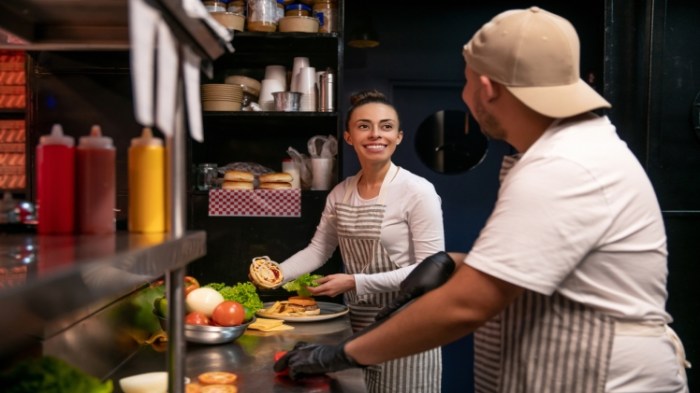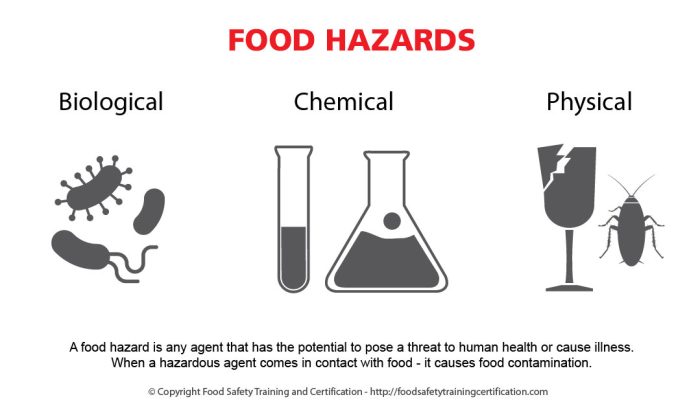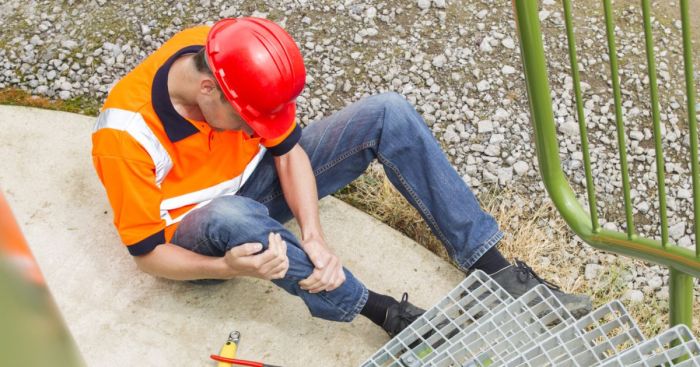As how should workers prevent physical food hazards from injuring customers takes center stage, this opening passage beckons readers into a world crafted with academic rigor and authoritative tone, ensuring a reading experience that is both absorbing and distinctly original.
This comprehensive guide delves into the realm of physical food hazards, empowering workers with the knowledge and strategies to safeguard customers from potential harm. By understanding the types and sources of physical hazards, implementing effective control measures, and engaging in continuous monitoring and training, food establishments can create a safe and wholesome dining environment.
Understanding Physical Food Hazards: How Should Workers Prevent Physical Food Hazards From Injuring Customers

Physical food hazards are objects or substances that can cause injury or illness if ingested. These hazards can range from small objects like glass shards or metal fragments to larger objects like bones or jewelry. Understanding the different types of physical food hazards is crucial for preventing them from injuring customers.
Examples of physical food hazards commonly found in food establishments include:
- Glass shards from broken dishes or containers
- Metal fragments from machinery or packaging
- Bones from meat or fish
- Jewelry or other personal items
- Hair or other bodily fluids
- Plastic or paper fragments from packaging
Identifying Potential Sources of Physical Hazards
Physical hazards can originate from various areas in a food establishment, including:
- Raw materials: Physical hazards can be introduced into food during harvesting, transportation, or storage of raw materials.
- Equipment: Faulty or damaged equipment can generate physical hazards, such as metal fragments or plastic shards.
- Packaging: Broken or contaminated packaging can allow physical hazards to enter the food.
- Personnel: Unsanitary practices or careless handling by food handlers can introduce physical hazards, such as hair or jewelry.
- Customers: Customers can accidentally or intentionally introduce physical hazards into food, such as bones or toothpicks.
- Implementing strict supplier quality controls to ensure that raw materials are free from physical hazards.
- Maintaining equipment in good working order and regularly inspecting it for potential hazards.
- Using proper packaging materials and ensuring that packaging is intact before use.
- Training food handlers on proper food handling techniques and personal hygiene.
- Educating customers about the importance of proper food handling and the potential risks of physical hazards.
- Using metal detectors or X-ray machines to inspect food products for metal fragments.
- Sieving or filtering food products to remove bones or other large objects.
- Implementing visual inspection programs to identify and remove physical hazards.
- Establishing food handling procedures that minimize the risk of cross-contamination.
- Providing training and education to food handlers on the importance of control measures.
- Conducting regular visual inspections of food products, equipment, and work areas.
- Monitoring customer complaints and investigating any reports of physical hazards.
- Maintaining records of all inspections and corrective actions taken.
- Reviewing and updating monitoring and inspection procedures regularly to ensure their effectiveness.
- Identifying and recognizing physical hazards.
- Proper food handling and storage techniques.
- Personal hygiene and sanitation practices.
- Control measures and inspection procedures.
- Customer education and communication.
Preventing Physical Food Hazards
Best practices for preventing physical hazards from entering the food supply include:
Implementing Control Measures
Control measures are essential for minimizing the risk of physical hazards in food establishments. These measures include:
Monitoring and Inspection
Regular monitoring and inspection are crucial for identifying and addressing potential physical hazards. This involves:
Training and Education, How should workers prevent physical food hazards from injuring customers
Training and educating food handlers on physical hazard prevention is essential for ensuring food safety. Training programs should cover topics such as:
Detailed FAQs
What are the most common types of physical food hazards?
Physical food hazards encompass a wide range of objects that can cause injury if ingested, including glass, metal, plastic, wood, and stones.
How can workers identify potential sources of physical hazards in a food establishment?
Potential sources of physical hazards can be identified by conducting thorough inspections of equipment, work areas, and food products, as well as by observing food handling practices and storage conditions.
What are the key elements of an effective monitoring and inspection program for physical food hazards?
An effective monitoring and inspection program should include regular visual inspections, temperature monitoring, metal detection, and periodic audits to identify and address potential hazards.


